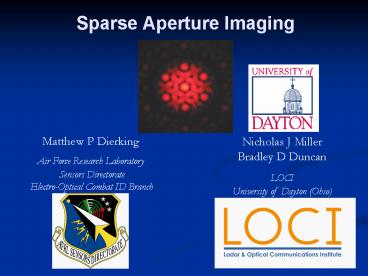Sparse Aperture Imaging PowerPoint PPT Presentation
1 / 63
Title: Sparse Aperture Imaging
1
Sparse Aperture Imaging
Matthew P Dierking Air Force Research Laboratory
Sensors Directorate Electro-Optical Combat ID
Branch
Nicholas J Miller Bradley D Duncan LOCI Universit
y of Dayton (Ohio)
2
Sparse Aperture Imaging
- Objective
- Resolution metrics (PSF and MTF)
- Designing optimized sparse arrays
- Inter-aperture phase aberrations
- Imaging experiment
- Future work
- Conclusions
3
Why construct sparse aperture imaging arrays?
- The resolution of a conventional,
diffraction-limited optical imaging system is
determined by its aperture diameter. - Can we synthesize a large effective aperture
(yielding higher resolution) from multiple,
strategically located sub-apertures? YES. - We will construct a sparse aperture array from
identical, unit-diameter, diffraction-limited
circular apertures.
4
Sparse aperture array with resolution equivalent
to a single, large aperture
Sparse aperture figure of merit, fill factor
5
Sparse Aperture Imaging
- Objective
- Resolution metrics (PSF and MTF)
- Designing optimized sparse arrays
- Inter-aperture phase aberrations
- Imaging experiment
- Future work
- Conclusions
6
PSF resolution metrics
- FWHM of central peak
- Peak-to-Integrated-Side- Lobe-Ratio, PISLR
7
MTF resolution metrics
raxx
- Spatial frequency cutoff
- Mid-frequency MTF level
rmin
We define, Deff rmin(lf)
8
Sparse Aperture Imaging
- Objective
- Resolution metrics (PSF and MTF)
- Designing optimized sparse arrays
- Inter-aperture phase aberrations
- Imaging experiment
- Future work
- Conclusions
9
Optimized two-dimensional arraysGolay described
point arrays having compact nonredundant
autocorrelations
Autocorrelation
Point array
10
PSF and MTF of a Golay-3 array
11
PSF and MTF of a Golay-6 array
12
PSF and MTF of a Golay-9 array
13
PSF and MTF of a Golay-12 array
14
Golay-9 array Optimization by expansion factor
Expansion factor s/D
15
Golay-9 array 1.0 expansion factor
16
Golay-9 array 1.1 expansion factor
17
Golay-9 array 1.2 expansion factor
18
Golay-9 array 1.3 expansion factor
19
Golay-9 array 1.4 expansion factor
20
Golay-9 array 1.5 expansion factor
21
Golay-9 array 1.6 expansion factor
22
Golay-9 array 1.7 expansion factor
23
Golay-9 array Optimization by expansion factor
Expansion factor considered optimized when
MTFmin 0.03 in passband
24
Quality measures of optimized N sub-aperture
Golay arrays
Selected as optimal sparse aperture array
Recall our figure of merit,
25
Sparse Aperture Imaging
- Objective
- Resolution metrics (PSF and MTF)
- Designing optimized sparse arrays
- Inter-aperture phase aberrations
- Imaging experiment
- Future work
- Conclusions
26
Golay-9 array Piston added to a single
sub-aperture
27
Golay-9 array 0l/10 piston applied to single
sub-aperture
28
Golay-9 array 1l/10 piston applied to single
sub-aperture
29
Golay-9 array 2l/10 piston applied to single
sub-aperture
30
Golay-9 array 3l/10 piston applied to single
sub-aperture
31
Golay-9 array 4l/10 piston applied to single
sub-aperture
32
Golay-9 array 5l/10 piston applied to single
sub-aperture
33
Golay-9 array 6l/10 piston applied to single
sub-aperture
34
Golay-9 array 7l/10 piston applied to single
sub-aperture
35
Golay-9 array 8l/10 piston applied to single
sub-aperture
36
Golay-9 array 9l/10 piston applied to single
sub-aperture
37
Golay-9 array 10l/10 piston applied to single
sub-aperture
38
Golay-9 array Tilt aberrations on a single
sub-aperture
39
Golay-9 array 0l/5 tilt applied to single
sub-aperture
40
Golay-9 array l/5 tilt applied to single
sub-aperture
41
Golay-9 array 2l/5 tilt applied to single
sub-aperture
42
Golay-9 array 3l/5 tilt applied to single
sub-aperture
43
Golay-9 array 4l/5 tilt applied to single
sub-aperture
44
Golay-9 array 5l/5 tilt applied to single
sub-aperture
45
Golay-9 array 6l/5 tilt applied to single
sub-aperture
46
Golay-9 array 7l/5 tilt applied to single
sub-aperture
47
Golay-9 array 8l/5 tilt applied to single
sub-aperture
48
Golay-9 array 9l/5 tilt applied to single
sub-aperture
49
Golay-9 array 10l/5 tilt applied to single
sub-aperture
50
Sparse Aperture Imaging
- Objective
- Resolution metrics (PSF and MTF)
- Designing optimized sparse arrays
- Inter-aperture phase aberrations
- Imaging experiment
- Future work
- Conclusions
51
Incoherently imaging a resolution target with a
Golay aperture array
Golay pupil masks
52
ISO 12233 resolution target Transmissive chrome
on glass chart Chart dimensions 15.2 by 11.4 mm
53
Horizontal and vertical MTFs of single aperture
54
Horizontal and vertical MTFs of Golay-3 array
55
Horizontal and vertical MTFs of Golay-6 array
56
Horizontal and vertical MTFs of Golay-9 array
57
Horizontal and vertical MTFs of Golay-12 array
58
MTF attenuation means reduced contrast compared
to filled apertures
- MTF is a measure of contrast transference. We
observed that, , for a
sparse aperture imaging system which means
reduced contrast at middle spatial frequencies. - Therefore, a practical sparse aperture imaging
system should employ a post-detection restoration
filter, such as a least squares Wiener filter, to
improve image contrast.
59
Golay-1 raw and Wiener restored images
60
Golay-9 raw and Wiener restored images
61
Future work
- Instead of using the large imaging lens to
combine optical beams prior to detection, use a
coherent detection method to directly measure
both the focal plane intensity and phase at each
sub-aperture.
62
Synthesis of sub-aperture field by a single
imaging lens (a) Post-detection synthesis of
intensity images by virtual lens (b)
63
Conclusions
- Optical sparse aperture imaging was theoretically
shown to enhance resolution over a single
monolithic aperture of equal total area. - The enhanced resolution was verified by
calculation of MTF from experimental edge images. - The resolution gain of a sparse aperture imaging
system comes at a cost -- loss of contrast and
reduced SNR. We successfully applied a
restoration filter to recover lost contrast. - Sparse arrays require accurate phasing of the
multiple sub-apertures.

